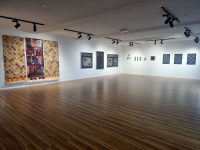
Nina Oberg Humphries is both artist and founder of the Tagata Moana Trust, a not for profit organisation committed to advocating for Pacific peoples through its policies, events and community resources to highlight and strengthen the visibility and identity of Pacific people.
Born in Ōtautahi Christchurch (b.1990), Oberg Humphries is of Cook Islands and Pākehā descent and a graduate from the Ilam School of Fine Arts. Central to her and the Tagata Moana Trust is the commitment to Pacific arts, languages, culture, knowledge and learning, delivered through a strategy titled STEAM, (Science, Technology, Engineering, Arts and Maths) as a means for Pacific peoples of all ages to find meaningful opportunities and thrive.
Oberg Humphries has recently opened Fibre Gallery at 285 Cashel Street in the central city, a gallery space for Pacific artists and education. The first of its kind in Te Wai Pounama the South Island, it is an exhibition space and centre that she describes as ‘dedicated to the display of community engaged digital and heritage artworks by Moana creatives.’ Its opening exhibition featured the work of three prominent senior contemporary Pacific artists: Filipe Tohi, Dagmar Dyck and Kulimoe’anga Stone Maka, in a group exhibition thematically titled and representing the gallery’s agenda and politics, Patterns of the Past – Formating the Future, and when interviewed Oberg Humphries emphasizes the gallery’s role: ‘We are a distinctively moana gallery showcasing Pacific artists from throughout Aotearoa with 50 % centred on South Island artists.’
‘Tagata Moana Trust had the opportunity to lease the upper floor at the beginning of the year. There was a big empty space in the middle of it and we thought it would be great as an art gallery. There wasn’t anywhere in Ōtautahi for us as a Pacific arts community to be represented. This is not a gallery for myself it is for this specific community, for people making work in their garage who have been thinking that they were not artists.’
‘The big thing that I keep hearing is that there only four visual artists working in Christchurch who are Pacific artists; me, Jon Jeet, Lonnie Hutchison and Kulimoe'anga Stone Maka.. There are others but not many that see themselves as artist. The gallery’s programme is for people who have never shown before and to really have somewhere for our Pacific artists to be part of a growing community to show their work and to have a North/South land relationship between artists and the knowledge that they bring to their work.’
‘Pacific people do not have a thriving making community in Christchurch. There is no one weaving fine woven mats and we need these things out in our community so there are places of belonging and identity. There are more opportunities in Auckland and its galleries and is a different type of making from the work coming from the South Island, so it is important that we have more artists working from here. At present they do not know that they are making great work, and that there are things that they make at home that have a life to them. For example, there is a chap in Woolston who makes things based around Pacific motifs, cutting them out and adding lights to them, and he says; ‘I like doing this and he plays around with it. We are going out to our community for proposals and we have an idea of people that we would like to give opportunities to. We see this gallery as in between all those spaces.’
In addition to the gallery, 285 Cashel Street also has a classroom and a space for workshops. ‘We are looking at their use being determined by whoever wants to use them. We want people who can talk about heritage art, making tapa , weaving different textiles and costume design and services and there is a digital space for laptops with creative software, a garment printer and laser cutter which are all free to use.’
‘We also need to build capacity for our heritage arts as central to supporting our identity. Otherwise everything is just a perpetual cycle of doom. Pacific peoples make up less than 5% of those employed in STEAM (Science, Technology, Engineering, Arts and Math) industries throughout Aotearoa. So we use Pacific arts to drive education and art because it is my interest.’
‘I believe that artists are the ones who keep and hold our cultural knowledge. Artists are working in so many different fields that they relate to these aspects of STEAM and they are of interest to our kids and families. They can find value in that and STEAM subjects which are better jobs, higher wages and opportunities. By amplifying the arts we can bridge the gaps between us and higher education. STEAM is in Pasifika peoples DNA, it is not a foreign concept. Pasifika ancestors built glorious Vaka that sailed by the wind and navigated by the stars across the world’s largest ocean. This kind of resilience, ingenuity and agility doesn’t just go away.’
DETAILS
Filipe Tohi, Dagmar Dyck and Kulimoe’anga Stone Maka, Patterns of the Past – Formating the Future,
Fibre Gallery, Level 1, 285 Cashel Street
See: https://tagatamoana.com/fibre-gallery
IMAGE
- Kulimoe’anga Stone Maka, Kumi ē Manatu, 2021, smoke, enamel on spider web on canvas, courtesy of the Jonathan Smart Gallery, photograph, Vicki Piper.
- From left, works by Dagmar Dyck, Kulimoe’anga Stone Maka and Filipe Tohi. Fibre Gallery Opening Exhibition
